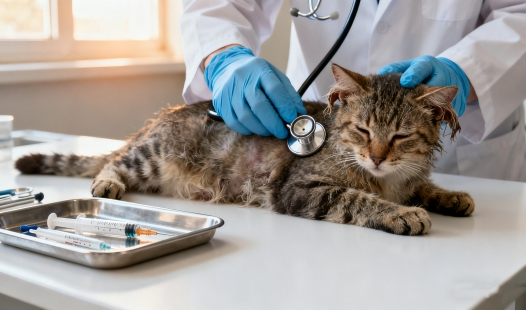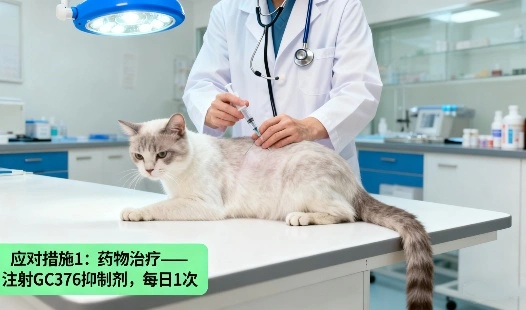How to adjust GS 441524 dosage for kittens or underweight cats?
Pediatric dosing considerations for GS-441524
Particular care is needed while administering the dosage of GS 441524 FIP to treat feline infectious peritonitis (FIP) in kittens and cats who are underweight. To ensure safety and efficacy in smaller or younger felines, it is essential to alter the dose of this antiviral medicine appropriately, despite its exceptional success in curing FIP. This detailed guide will help veterinarians and cat owners enhance treatment results by exploring the subtleties of altering GS-441524 doses for kittens and cats with low body weight.


Pediatric dosing considerations for GS-441524
When it comes to treating kittens with GS-441524, several factors must be taken into account to ensure safe and effective dosing. The developing bodies of young cats require careful attention to medication administration.
Age-based dosing guidelines
When treating kittens with GS-441524, veterinarians must pay close attention to the animal's age and developmental stage to determine the safest and most effective dosage. Very young kittens often have underdeveloped organ systems, meaning their ability to metabolize and process medication differs significantly from that of adult cats. Therefore, treatment usually begins with a conservative dose that is gradually increased as the kitten grows and its metabolic functions mature. Regular veterinary assessments during this process help ensure the medication remains both safe and effective. This age-based approach minimizes the risk of drug accumulation or side effects while maintaining the therapeutic levels needed to control FIP progression effectively.
Weight-based calculations
Weight is one of the most crucial factors in determining the proper GS 441524 dose for kittens. Since kittens grow rapidly, even small changes in body weight can significantly impact how the drug is distributed and metabolized in their system. Veterinarians typically calculate the dosage per kilogram to ensure precise and individualized treatment. Inaccurate dosing — whether too high or too low — can lead to treatment failure or unnecessary side effects. To prevent this, regular weight monitoring, sometimes weekly, is recommended throughout the course of therapy. This ongoing adjustment helps maintain the right balance between efficacy and safety, ensuring that each kitten receives the optimal therapeutic dose as it grows.
Metabolic considerations
Kittens have immature liver and kidney function, which can alter how GS-441524 is metabolized and excreted. Because of this, veterinarians must exercise extra caution when initiating antiviral therapy in young cats. Lower starting doses are often advised to avoid overwhelming the kitten's developing detoxification systems. As the treatment progresses, veterinarians may increase the dosage gradually, guided by clinical response and laboratory results. Close monitoring for signs of toxicity, such as loss of appetite, vomiting, or lethargy, is essential. Adjustments are made accordingly to maintain therapeutic efficacy without compromising safety. Understanding these metabolic differences is vital for achieving successful FIP treatment outcomes in kittens while minimizing potential adverse effects.
 |
 |
Modifications for cats with low body condition
Underweight or malnourished cats require special attention when determining appropriate GS-441524 dosages. Their compromised health status can impact how they process and respond to the medication.
Before initiating treatment, veterinarians evaluate the cat's body condition score (BCS) to determine the degree of underweight status. This assessment helps guide dosing decisions and nutritional support strategies.
Cats with low body weight may require dosage reductions to prevent overexposure to the medication. However, it's crucial to balance this with maintaining therapeutic levels to effectively combat the FIP virus.
Implementing a nutritional support plan alongside GS 441524 treatment is vital for underweight cats. Improved nutrition can help strengthen the immune system and support the cat's ability to tolerate and benefit from the medication.
 |
 |
 |
Monitoring small or underweight cats during treatment
Close monitoring is essential when treating kittens or underweight cats with GS-441524 to ensure optimal outcomes and minimize potential complications.
Frequent weight checks
Regular weighing, often daily or every few days, allows for precise dosage adjustments as the cat gains weight and strength during treatment.
Blood work and clinical assessments
Routine blood tests and physical examinations help veterinarians track the cat's response to treatment and detect any adverse effects early. This may include monitoring liver and kidney function, as well as hematological parameters.
Observing for side effects
Kittens and underweight cats may be more susceptible to side effects. Careful observation for signs of gastrointestinal upset, changes in behavior, or other adverse reactions is crucial.
Conclusion
Adjusting GS-441524 dosages for kittens and underweight cats requires a delicate balance of scientific knowledge and clinical experience. While GS-441524 cost is an important consideration for many cat owners, proper dosing and monitoring should always take priority to ensure safety and effectiveness. By carefully considering factors such as age, weight, and overall health status, veterinarians can optimize treatment protocols to give these vulnerable felines the best chance at overcoming FIP. Regular monitoring and willingness to make dosage adjustments throughout the treatment course are key to success. As research in this area continues to evolve, staying informed about the latest recommendations for GS-441524 use in pediatric and compromised patients remains crucial for achieving the best possible outcomes in FIP treatment.
FAQ
1. Q: How often should GS-441524 dosages be adjusted for growing kittens?
A: Dosage adjustments for growing kittens should typically be made weekly or bi-weekly, depending on their growth rate and response to treatment. Regular weight checks are essential to ensure accurate dosing.
2. Q: Can underweight adult cats receive the standard GS-441524 dosage?
A: Underweight adult cats may require dosage modifications based on their current weight and overall health status. It's important to consult with a veterinarian experienced in FIP treatment to determine the appropriate dosage.
3. Q: Are there any special considerations for administering GS-441524 to neonatal kittens?
A: Neonatal kittens require extremely careful dosing and may not be suitable candidates for GS-441524 treatment in some cases. Treatment decisions should be made on a case-by-case basis in consultation with a veterinary specialist.
Optimize Your FIP Treatment with BLOOM TECH's Premium GS-441524
You must ensure that your supply of GS-441524 is of the highest quality and consistency for treating feline infectious peritonitis (FIP) in kittens and underweight cats. While GS-441524 cost can vary depending on dosage and duration, investing in veterinarian-grade products ensures both safety and efficacy. Veterinarian-grade GS-441524 is available from BLOOM TECH, and its unmatched potency and purity guarantee the best possible treatment results for even the most delicate feline patients. An item that satisfies the most exacting requirements for safety and effectiveness is assured by our sophisticated production methods and rigorous quality control procedures. If you want to provide your feline patients the greatest opportunity of conquering FIP, BLOOM TECH is the company you trust for trustworthy, high-quality GS-441524. For inquiries about our premium GS-441524 or to discuss your specific veterinary needs, please contact our dedicated support team at Sales@bloomtechz.com. Partner with BLOOM TECH - your trusted GS-441524 supplier for exceptional FIP treatment solutions.
References
1. Pedersen, N.C., et al. (2019). Efficacy and safety of the nucleoside analog GS-441524 for treatment of cats with naturally occurring feline infectious peritonitis. Journal of Feline Medicine and Surgery, 21(4), 271-281.
2. Murphy, B.G., et al. (2020). Treatment of cats with feline infectious peritonitis with a nucleoside analog GS-441524. Animals, 10(3), 384.
3. Dickinson, P.J., et al. (2020). Antiviral treatment using the adenosine nucleoside analogue GS-441524 in cats with clinically diagnosed neurological feline infectious peritonitis. Journal of Veterinary Internal Medicine, 34(4), 1587-1593.
4. Addie, D.D., et al. (2020). Feline infectious peritonitis. ABCD guidelines on prevention and management. Journal of Feline Medicine and Surgery, 22(11), 1047-1068.

Echo
9 years of experience in chemical articles; Doctoral degree; Organic Chemistry major; R&D-4 Dept; Technology support; R&D engineer
Anticipating your Business & Technology support inquiry
Please send us the products that interest you, and we will provide you with one-on-one service
Recommended Blog



_副本_1758243222799.webp)

_副本_1758165165105.webp)


_副本_1760580791986.webp)
_副本_1761532705861.webp)
_副本_1760064950733.webp)

